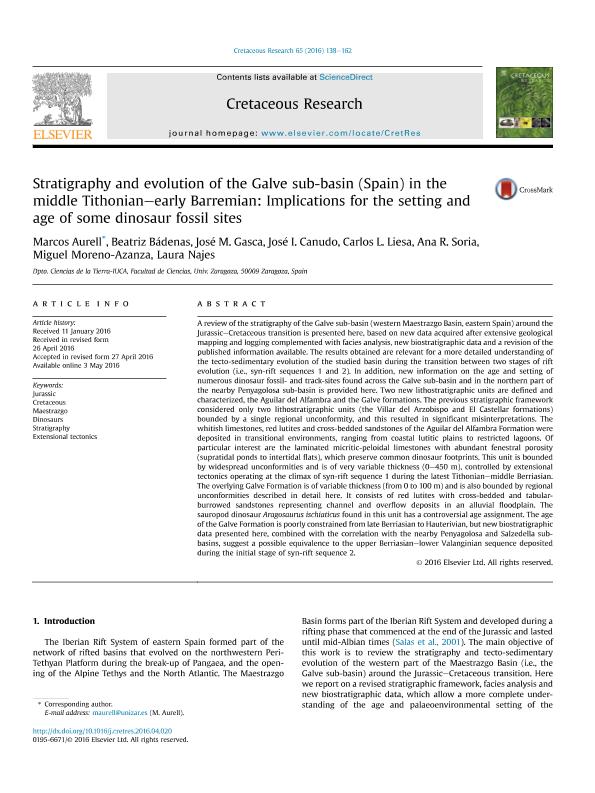Artículo
Stratigraphy and evolution of the Galve sub-basin (Spain) in the middle Tithonian-early Barremian: Implications for the setting and age of some dinosaur fossil sites
Aurell, Marcos; Bádenas, Beatriz; Gasca Pérez, José Manuel ; Canudo, José I.; Liesa, Carlos L.; Soria, Ana R.; Moreno Azanza, Miguel; Najes, Laura
; Canudo, José I.; Liesa, Carlos L.; Soria, Ana R.; Moreno Azanza, Miguel; Najes, Laura
 ; Canudo, José I.; Liesa, Carlos L.; Soria, Ana R.; Moreno Azanza, Miguel; Najes, Laura
; Canudo, José I.; Liesa, Carlos L.; Soria, Ana R.; Moreno Azanza, Miguel; Najes, Laura
Fecha de publicación:
10/2016
Editorial:
Academic Press Ltd - Elsevier Science Ltd
Revista:
Cretaceous Research
ISSN:
0195-6671
Idioma:
Inglés
Tipo de recurso:
Artículo publicado
Clasificación temática:
Resumen
A review of the stratigraphy of the Galve sub-basin (western Maestrazgo Basin, eastern Spain) around the Jurassic-Cretaceous transition is presented here, based on new data acquired after extensive geological mapping and logging complemented with facies analysis, new biostratigraphic data and a revision of the published information available. The results obtained are relevant for a more detailed understanding of the tecto-sedimentary evolution of the studied basin during the transition between two stages of rift evolution (i.e., syn-rift sequences 1 and 2). In addition, new information on the age and setting of numerous dinosaur fossil- and track-sites found across the Galve sub-basin and in the northern part of the nearby Penyagolosa sub-basin is provided here. Two new lithostratigraphic units are defined and characterized, the Aguilar del Alfambra and the Galve formations. The previous stratigraphic framework considered only two lithostratigraphic units (the Villar del Arzobispo and El Castellar formations) bounded by a single regional unconformity, and this resulted in significant misinterpretations. The whitish limestones, red lutites and cross-bedded sandstones of the Aguilar del Alfambra Formation were deposited in transitional environments, ranging from coastal lutitic plains to restricted lagoons. Of particular interest are the laminated micritic-peloidal limestones with abundant fenestral porosity (supratidal ponds to intertidal flats), which preserve common dinosaur footprints. This unit is bounded by widespread unconformities and is of very variable thickness (0-450 m), controlled by extensional tectonics operating at the climax of syn-rift sequence 1 during the latest Tithonian-middle Berriasian. The overlying Galve Formation is of variable thickness (from 0 to 100 m) and is also bounded by regional unconformities described in detail here. It consists of red lutites with cross-bedded and tabular-burrowed sandstones representing channel and overflow deposits in an alluvial floodplain. The sauropod dinosaur Aragosaurus ischiaticus found in this unit has a controversial age assignment. The age of the Galve Formation is poorly constrained from late Berriasian to Hauterivian, but new biostratigraphic data presented here, combined with the correlation with the nearby Penyagolosa and Salzedella sub-basins, suggest a possible equivalence to the upper Berriasian-lower Valanginian sequence deposited during the initial stage of syn-rift sequence 2.
Palabras clave:
Cretaceous
,
Dinosaurs
,
Extensional Tectonics
,
Jurassic
,
Maestrazgo
,
Stratigraphy
Archivos asociados
Licencia
Identificadores
Colecciones
Articulos(CCT - PATAGONIA NORTE)
Articulos de CTRO.CIENTIFICO TECNOL.CONICET - PATAGONIA NORTE
Articulos de CTRO.CIENTIFICO TECNOL.CONICET - PATAGONIA NORTE
Citación
Aurell, Marcos; Bádenas, Beatriz; Gasca Pérez, José Manuel; Canudo, José I.; Liesa, Carlos L.; et al.; Stratigraphy and evolution of the Galve sub-basin (Spain) in the middle Tithonian-early Barremian: Implications for the setting and age of some dinosaur fossil sites; Academic Press Ltd - Elsevier Science Ltd; Cretaceous Research; 65; 10-2016; 138-162
Compartir
Altmétricas



